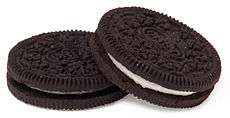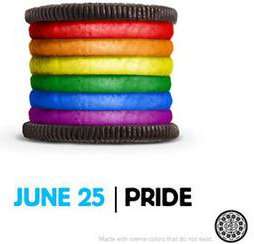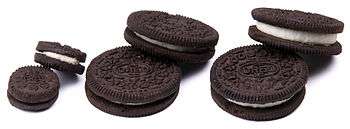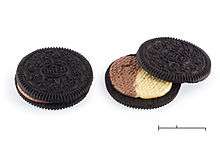Oreo
 | |
 Two Oreo cookies | |
| Owner | Nabisco (Mondelēz International) and Cadbury |
|---|---|
| Country | United States |
| Introduced | March 6, 1912 |
| Markets | World |
| Tagline |
"Wonderfilled" "Milk's favorite cookie" |
| Website | Oreo.com |
Oreo (/ˈɔːrioʊ/) is a sandwich cookie consisting of two chocolate wafers with a sweet creme filling in between, and (as of 1974) are marketed as "Chocolate Sandwich Cookies" on the package in which they are held. The version currently sold in the United States is made by the Nabisco division of Mondelēz International. Oreo has become the best-selling cookie in the United States since its introduction in 1912.[1]
Etymology
The origin of the name Oreo is unknown, but there are many theories, including derivations from the French word 'Or', meaning gold (as early packaging was gold), or the Greek word 'Oreo', meaning beautiful, nice or well done.[2] Others believe that the cookie was named Oreo because it was short and easy to pronounce.[3]
History

Twentieth century
The "Oreo Biscuit" was first developed and produced by the National Biscuit Company (today known as Nabisco) in 1912[4][5] at its Chelsea, Manhattan factory in the current-day Chelsea Market complex, located on Ninth Avenue between 15th and 16th Streets.[6] Today, this same block of Ninth Avenue is known as "Oreo Way."[6] The name Oreo was first trademarked on March 14, 1912.[7] It was launched as an imitation of the Hydrox cookie manufactured by Sunshine company, introduced in 1908.[8]
The original design of the cookie featured a wreath around the edge of the cookie and the name "OREO" in the center.[9] In the United States, they were sold for 25 cents a pound (453 g) in novelty cans with clear glass tops. The first Oreo was sold on March 6, 1912 to a grocer in Hoboken, New Jersey.[10]
The Oreo Biscuit was renamed in 1921, to "Oreo Sandwich."[2] A new design for the cookie was introduced in 1924.[9] A lemon-filled variety was available briefly during the 1920s, but was discontinued.[9] In 1948, the Oreo Sandwich was renamed the "Oreo Creme' Sandwich"; it was changed in 1974 to the Oreo Chocolate Sandwich Cookie.[2] The modern-day Oreo design was developed in 1952 by William A. Turnier,[11] to include the Nabisco logo.
The modern Oreo cookie filling was developed by Nabisco's principal food scientist, Sam Porcello.[6][12] Porcello held five patents directly related to his work on the Oreo.[12] He also created a line of Oreo cookies covered in dark chocolate and white chocolate.[6][12] Porcello retired from Nabisco in 1993.[6] In the early 1990s, health concerns prompted Nabisco to replace the lard in the filling with partially hydrogenated vegetable oil.[13] Oreo cookies are popular with certain dietary restrictions, like vegans, because the cream inside the cookie is not made from any animal products,[14] however, there is a risk of cross-contamination from other dairy-containing products made in the same production areas.[15]
Twenty-first century
Starting in January 2006, Oreo cookies replaced the trans fat in the cookie with non-hydrogenated vegetable oil.[13][16][17]
Nabisco began a marketing program in 2008, advertising the use of Oreo cookies in a game called DSRL, which stands for "Double Stuf Racing League." The DSRL was introduced one week prior to Super Bowl XLII. This sport had also been endorsed by football brothers Peyton Manning and Eli Manning.[18] Sisters Venus and Serena Williams have also joined, and challenged the Mannings to a race, which aired in an ad on January 18, 2009.[19] Another campaign started for Golden Double Stuf Oreo cookies with the brothers being challenged by Donald Trump and "Double Trump", played by Darrell Hammond; the date for this competition was January 24, 2010. The Mannings won in both cases. A new ad campaign is currently revolving around a 'Hooded Menace' threatening to take over the Double Stuf Racing League, and Eli Manning and Stufy (the DSRL mascot) needing some help airing beginning on or around September 14, 2010. Six days later, it was announced that Shaquille O'Neal and Apolo Ohno joined Oreo Double Stuf Racing League vets Eli Manning and Venus Williams.
In April 2011, Oreo announced its special edition Oreo cookies with blue creme in promotion of the 2011 3D computer animated film Rio. The promotion included stickers inside each package of cookies. Two types of contests were also announced: first, by completing an album of stickers, consumers could win three movie passes and medium snack bar combos; second, by finding winning stickers in packages with prizes, including a trip to Rio de Janeiro, backpacks, cinema passes for a year, and 3D glasses. The promotion ended May 30, 2011,[20] and was available in Ecuador, Peru, and Colombia.[21]

In June 2012, Oreo posted an ad displaying an Oreo cookie with rainbow colored cream to commemorate Gay Pride month.[22] The cookie itself is not being manufactured or available for sale. The ad prompted some negative comments but Kraft stood by their promotion stating "Kraft Foods has a proud history of celebrating diversity and inclusiveness. We feel the Oreo ad is a fun reflection of our values."[23] The Gay Pride ad was followed during 2012 by a series of ads commemorating other holidays and events, including a red, white and blue cream Oreo for Bastille Day, a stream of cookie crumbs for the appearance of the Delta Aquarid meteor shower, and a cookie with a jagged bite taken out of it for Shark Week.
International distribution
Oreo cookies are distributed worldwide through a variety of sales and marketing means. In the United Kingdom, since May 2008, following stocking of Oreo (called Oreo biscuits in UK) in the supermarket chain Sainsbury's, Kraft decided to fully launch the Oreo across the UK, repackaged in the more familiar British tube design, accompanied with a £4.5M television advertising campaign around the 'twist, lick, dunk' catchphrase.[24] Kraft recently partnered with McDonald's to bring the Oreo McFlurry (already on sale in many countries) to a few McDonald's locations during its yearly Great Tastes of America promotions, as of October 2015 the Oreo McFlurry became a permanent menu item at McDonald's in the United Kingdom. An Oreo flavored "Krushem" drink was also on sale in UK KFC stores. The UK Oreo website gives a slightly different ingredients list to that of the US product. Unlike the US version, UK Oreo cookies originally contained whey powder and so were not suitable for people who avoid milk products. As the whey powder was sourced from cheese made with calf rennet, UK Oreo cookies were also not suitable for vegetarians.[25] On 6 December 2011, Kraft announced that Oreo cookies would start to be produced in the UK. Their Cadbury factory at Sheffield in South Yorkshire was selected to manufacture Oreo cookies in the UK for the first time. Production started on May 2013.[26]
According to the Kraft Foods Company the Oreo is the "World's Best Selling Cookie".[27] As the popularity of Oreos continues to grow, so does the amount of distribution that comes with it. In March 2012, Time Magazine reported that Oreos were available in more than 100 different countries. Overall, it is estimated that since the Oreo cookie's inception in 1912 that over 450 billion Oreos have been produced worldwide. The United States, China, Venezuela, Canada, and Indonesia round out the top 5 countries in terms of sales.[28]
Production
According to a statement from Kim McMiller, an Associate Director of Consumer Relations, a two-stage process is used to make Oreo cookies. The base cake dough is formed into the familiar round cookies by a rotary mold at the entrance of a 300-foot-long oven.
Much of Oreo production was once done at the Hersheys factory in Hershey, Pennsylvania. Oreo cookies for the Asian markets are manufactured in Indonesia, India and China, except for Japan where Oreo was manufactured locally under the brand "Yamazaki-Nabisco". Oreo cookies for Europe are made in Spain and in Russia (Mondelēz Rus') for consumers in several CIS countries. Oreo cookies sold in Australia are manufactured in Indonesia (previously China) or Spain, depending on flavor. The Canadian produced version (sold under the Christie's brand) includes coconut oil and is sold only in that region. Manufacturing of Oreo biscuits in Pakistan began in early 2014 at the production plant of Continental Biscuits Limited in Sukkur, Pakistan in collaboration with Mondelez International of the United States and Continental Biscuits Limited of Pakistan.
Oreo boycott
In 2015, Mondelez announced its decision to close some of its American factories and move Oreo production to Mexico, prompting the Oreo boycott.[29] In 2016, after production had started in Mexico, the AFL-CIO encouraged the boycott and published consumer guidance to help identify which Mondelez products were made in Mexico.[30]
In July 2016, Oreo cookies ceased being made in Chicago, US.[31]
Varieties
In addition to their traditional design of two chocolate wafers separated by a cream filling, Oreo cookies have been produced in many different varieties since they were first introduced, and this list is only a guide to some of the more notable and recent types; not all are available in every country. Notable flavors in the US are:

- Double Stuf Oreo (introduced in 1974)[32] have about twice the normal amount of white creme filling. Available in peanut butter, original, cool mint, chocolate creme, and birthday cake. In the UK they are called Double Stuff Oreo (note the double 'f') and are currently only available in original.
- Mega Stuf Oreo introduced in February 2013, are similar to Double Stuf Oreo cookies, but with even more white cream filling. They come in both chocolate and golden varieties.
- Football Oreo football-shaped Oreo cookies, introduced in 1976
- Big Stuf Oreo (introduced in 1987)[32] were several times the size of a normal Oreo. Sold individually, each Big Stuf contained 250 calories (1,000 kJ)[33] and 13 grams of fat. They were discontinued in 1991.
- Mini Oreo, originally released in 1991,[34] are bite-sized versions of ordinary Oreo cookies. After being discontinued in the late 1990s they were re-released in 2000 along with the redesigned 2001 Dodge Caravan as part of a promotional tie-in with DaimlerChrysler[35] Their 1990s packaging consisted of a "miniaturized" version of the full-size cardboard tray and box used in packaging at the time. Their current packaging consists of an aluminum foil bag.. Mini Oreos are also available, in original and golden varieties, in Nabisco To-Go Cups, lidded plastic cups which fit into car cup-holders, along with other Nabisco snacks in miniature form, such as Nutter Butters. In 2015, a new flavor of the mini Oreo, mint, debuted.
- Oreo Thins, released in 2015, are thin versions of these cookies. They come in chocolate, golden and mint kinds. They have only 40 calories per cookie. At 66% thinner, and 33% less per bag at same cost.

- Chocolate Oreo, an Oreo cookie with chocolate filling instead of the original vanilla creme.
- During springtime, around Halloween, and Christmas, special edition "Double Stuf Oreo" cookies are produced with colored frosting reflecting the current holiday (blue or yellow, orange, and red or green respectively). Also, one side of each seasonal cookie is stamped with an appropriate design: the spring cookies feature flowers, butterflies, etc., and the Hallowe'en Oreos bear a jack o'lantern, ghost, cat, flock of bats, and/or broom-riding witch.

- Birthday Cake Oreo cookies were a limited edition release in February–July 2012 to celebrate Oreo's 100th birthday, made up of two chocolate Oreo cookies with a birthday-cake flavored filling and sprinkles inside. This edition replaced the traditional design on one of the two cookies with a birthday candle and the words "OREO 100". The flavor has been reintroduced, with "double stuff" amount of cream filling, in both chocolate and golden Oreo varieties, except that the cookies no longer display the "OREO 100" print.[36]
- Gingerbread Oreo cookies were a limited edition release made up of two golden Oreo cookies with a mild gingerbread flavored filling.
- Lemon Twist Oreo cookies were a limited edition release in 2012 that returned in 2013, made up of two golden Oreo cookies with a lemon flavored filling.
- Neapolitan Oreo cookies were a limited edition release in 2012, made up of three golden Oreo cookies with a double sandwich of chocolate and strawberry creme fillings.
- SpongeBob Oreo limited edition release in 2014, featuring chocolate cookies with yellow creme and one side of each cookie donning a SpongeBob SquarePants character design.[37]
- Fruit Punch Oreo limited edition release in 2014, featuring vanilla cookies with fruit punch flavored creme.
- Cookie Dough Oreo limited edition release in March 2014, featuring chocolate cookies with cookie dough flavored creme.[38]
- Caramel Apple Oreo limited edition release in August 2014 exclusively at Target stores, featuring golden Oreo cookies with caramel apple flavored creme.[39]
- Pumpkin Spice Oreo limited edition release in September 2014. Golden Oreo cookies with pumpkin spice flavored filling.
- Red Velvet Oreo cookies were a limited edition release in February 2015. Red Oreo cookies with cream cheese flavored filling. The flavor has been reintroduced.
- Root Beer Float limited edition release in July 2014, made of two gold Oreo Cookies filled with root beer flavored creme.
- Key Lime Pie limited edition release in July 2015, made of two graham flavored Oreo cookies filled with key lime creme.
- Cinnamon Bun cinnamon cookie filled with cinnamon bun flavored creme – released January 2016.
- Filled Cupcake released in 2016,[40] made like the Chocolate Oreo, except the center of the filling is replaced with a filling similar to that of a cupcake frosting. The cookie can be removed allowing one to lick the filling out of the center. It may be inspired by the Hostess Cupcake.
- S'mores released in summer 2016 made of a Graham flavored cookie with chocolate and marshmallow flavored frosting, inspired by the campfire snack.
- Blueberry Pie released in summer 2016. Made of a pie crust cookie with a blueberry filling
- Fruity Crisp released in summer 2016. Made of two golden Oreo cookies with a fruity and colorful rice crisp cream filling.
- Swedish Fish released in summer 2016. Swedish Fish flavored red filling.
Use as an ethnic slur
The term "Oreo" has been used as a derogatory reference to a black person who is perceived or judged to act in a "white manner." The racial slur may be levied as an accusation that the person called "Oreo" perpetuates the "un-level playing field for blacks." The racial epithet is used to imply that someone is like the cookie, "black on the outside and white on the inside".[41]
In popular culture
- In the 1976 film A Star Is Born, Barbra Streisand's character Esther Hoffman is (literally) the central member of The Oreos, a three-girl singing group, between black actresses Venetta Fields and Clydie King.
- In the 1978 Clint Eastwood film Every Which Way But Loose and its 1980 sequel Any Which Way You Can, Philo Beddoe's mother - Ma, played by Ruth Gordon - is involved in a long running battle with Clyde the Orangutan who continually hides her Oreos from her.
- The song "Oreo Cookie Blues" by Lonnie Mack describes the narrator's love of the cookies.
- In the 1984 movie "This is Spinal Tap" one of the eccentric items the guitarist "Nigel Tufnel" always requests in his dressing room is a plate of Oreo's top and bottom separated with the cream removed...
- The song "The White Stuff" by "Weird Al" Yankovic, off his 1992 album Off the Deep End, is a tribute to Oreos.
- In The Lost Boys (1987), the Grandpa character (portrayed by Barnard Hughes) keeps Double Stuf Oreos in his refrigerator.
- In the 1988 movie Big (film), Tom Hanks' character is shown eating Oreos in his motel room.
- In the 1998 movie Rounders, the main antagonist Teddy KGB (played by John Malkovich), is well known for his love for Oreo cookies, which he regularly eats even during poker games.
- In the 2012 animated movie Wreck-It Ralph, Oreo cookies serve as royal guards in King Candy's castle. They continually sing the word "Oreo" in a manner similar to the guards of the castle of the Wicked Witch of the West in The Wizard of Oz.
- The DC Comics character, Martian Manhunter has been shown to have a well known love for Oreo cookies.
- The 2014 film Transformers: Age Of Extinction features an Oreo-themed Transformer that was destroyed by the Autobots in the KSI factory.
See also
References
- ↑ Toops, Diane (July 1, 2005). "Top 10 power brands". FoodProcessing.com. Retrieved 2012-04-06.
In the enviable position of being the No. 1 selling cookie in America since its introduction in 1912, the Oreo, made by Nabisco, East Hanover, N.J., a brand of Kraft Foods, was a true innovation—two chocolate disks with a crème filling in between.
- 1 2 3 Feldman, David (1987). Why do clocks run clockwise? and other Imponderables. New York City: Harper & Row Publishers. pp. 173–174. ISBN 0-06-095463-9.
- ↑ "History of the Oreo Cookie". About. Retrieved 13 October 2014.
- ↑ "Oreo". Kraft Foods. January 3, 2011. Archived from the original on 2012-03-26. Retrieved 2011-03-02.
- ↑ "The Food Timeline: history notes--cookies, crackers & biscuits". Retrieved 2010-03-03.
- 1 2 3 4 5 Hinkley, David (2012-05-20). "Celebrating the life of 'Mr. Oreo'". New York Daily News. Retrieved 2012-06-02.
- ↑ "OREO - Trademark Details". Retrieved 2012-07-10.
- ↑ Paul Lukas (15 March 1999). "Oreos to Hydrox: Resistance Is Futile". Fortune. Retrieved 2009-11-29.
- 1 2 3 Eber, H. (February 26, 2012). "The Big O: The Chelsea-born Oreo cookie celebrates its 100th birthday". New York Post. pp. 44–45.
- ↑ Grossman, Samantha. 100 Years of Oreos: 9 Things You Didn't Know About the Iconic Cookie" Time (March 6, 2012)
- ↑ Wallace, Emily (August 24, 2011). "The story of William A. Turnier, the man who designed the Oreo cookie". Indyweek.com - Magazine Blog.
- 1 2 3 Locker, Melissa (2012-05-24). "RIP, 'Mr.Oreo': Man Who Invented Oreo Filling Dies At 76". Time Magazine (Time NewsFeed). Retrieved 2012-06-02.
- 1 2 Alexander, Delroy; Manier, Jeremy; Callahan, Patricia (August 23, 2005). "For every fad, another cookie". Chicago Tribune.
- ↑ "12 Surprising Vegan Foods". Huffington Post. September 13, 2013.
- ↑ "Frequently asked questions: Is Oreo suitable for vegans?". Retrieved 2016-06-08.
- ↑ Ascherio A, Stampfer MJ, Willett WC. "Trans fatty acids and coronary heart disease". Retrieved 2006-09-14.
- ↑ "The Campaign to Ban Partially Hydrogenated Oils". Ban Trans Fats. Retrieved 2013-11-16.
- ↑ "Manning Brothers Take On 'Second Sport' With a Twist, Lick and Dunk" (Press release). PRNewswire. January 14, 2009. Retrieved July 20, 2012.
- ↑ "Double Stuf Racing League". Nabisco. Archived from the original on March 17, 2009. Retrieved 2009. Check date values in:
|access-date=(help) - ↑ Promo Gana - Peru: Concurso Promo Oreo, gana paquetes de cine, viaje a Rio, mochiles y mas, April 8, 2011 Retrieved April 8, 2011 (Spanish)
- ↑ Official "Rio" Promotion Site Retrieved April 8, 2011
- ↑ Stephen Gray (26 June 2012). "Oreo unveils rainbow cookie image for Pride". Pink news. Retrieved 30 June 2012.
- ↑ "Rainbow-colored Oreo filled with controversy". Reuters. 26 June 2012. Retrieved 30 June 2012.
- ↑ BBC News Magazine Can Oreo win over British biscuit lovers?, 2 May 2008
- ↑ "NabiscoWorld". NabiscoWorld. 2006-01-01. Retrieved 2011-03-02.
- ↑ "Mondelez - $name". EU. Retrieved 13 October 2014.
- ↑ "Oreo Global Fact Sheet" (PDF).
- ↑ Grossman, Samantha (March 6, 2012). "100 Years of Oreos: 9 Things You Didn't Know About the Iconic Cookie". Time Magazine. Retrieved November 2, 2015.
- ↑ Joseph N. DiStefano (August 12, 2015). "Oreo sees support, but also backlash and boycott, for gay pride rainbow cookie". Philly.com. Retrieved July 9, 2015.
- ↑ Staff (May 4, 2016). "AFL-CIO endorsement of BCTGM's boycott of "Made in Mexico" Mondelez International snack foods". Afl-CIO. Retrieved May 4, 2016.
- ↑ Source: USA Today, July 12th, 2016. Page 6A.
- 1 2 "Fact Sheet: Oreo's 100th Birthday" (PDF). Nabisco. Retrieved July 20, 2012.
- ↑ Brataas, Anne (July 7, 1989). "The Era Of Gargantuan Gastronomy Belies Our Concern With Calories". Chicago Tribune via Knight-Ridder. Retrieved July 20, 2012.
- ↑ Foltz, Kim (1991-10-24). "RJR Nabisco Reports Neet Of $123 Million in 3d Quarter". Nytimes.com. Retrieved 2011-03-02.
- ↑ "New Mini Oreos Debut in New Mini Van". PR Newswire. 2000-08-10.
- ↑ "Product Search Results - Snackworks". com. Retrieved 13 October 2014.
- ↑ Armando Villaseñor. "Reconocimiento a Oreo - Multipress". Multipress.
- ↑ Moss, Michael (March 11, 2014). "The Cookie Dough Oreo". nytimes.com.
- ↑ "Caramel Apple Oreos Arrive In Target Stores Today". Consumerist. Retrieved 13 October 2014.
- ↑ Cave, James (February 2, 2016). "Oreo Debuts A New Flavor That Tastes Like A Filled Cupcake". Retrieved August 5, 2016.
- ↑ Griffin, Michael and James, Joni (January 14, 1998). "UF President Apologizes For Remark". Orlando Sentinel. Retrieved September 3, 2014.
External links
| Wikimedia Commons has media related to Oreo cookies. |
- Official website
- Snack Works (formerly NabiscoWorld website)
- Official UK website
- Additional history notes on Oreo cookies
- Interview with the winners of the Oreo and Milk Jingle Contest Sing-off with FOX News Radio